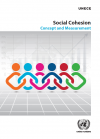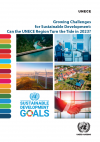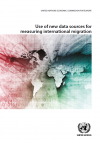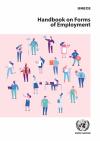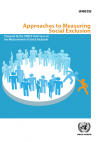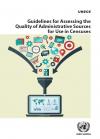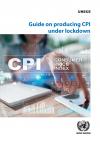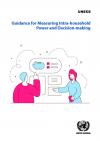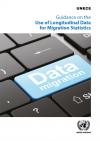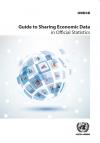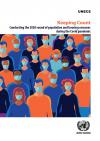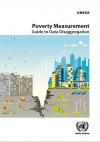Publications
Displaying Results 1 - 20 of 95
- English
ONLINE PUBLICATION
This publication provides the 2024 progress assessment on the Sustainable Development Goals (SDGs) in the region of the United Nations Economic Commission for Europe (UNECE), based on the data available in the United Nations Global SDG Indicators Database.
The results are presented at the regional level, identifying
- English
Social cohesion, broadly speaking, is the ‘glue’ that binds society together.
Societies with higher levels of social cohesion are healthier, more resilient to external shocks, and experience greater economic growth. An understanding of social cohesion helps us make sense of a wide range of topics including globalization, ethnic and group fragmentation, inequalities and barriers to social mobility
- English
ONLINE PUBLICATION
This publication provides a progress assessment on the Sustainable Development Goals (SDGs) in the region of the United Nations Economic Commission for Europe (UNECE), based on the data available in the United Nations Global SDG Indicators Database.
The results are presented at the regional level, identifying the SDG targets that the
- English
Migration and other forms of cross-border mobility are issues of high policy importance. Demands for statistics in these areas have further increased in light of the 2030 Agenda for Sustainable Development and the 2018 Global Compact for Safe, Orderly and Regular Migration. The statistical community continues to be challenged to capture international migration and cross-border mobility in a way
- English
The 1989 United Nations Convention on the Rights of the Child obliges parties to ensure all children have a fair chance in life. The development of national and international policies that provide all children and youth the best possible start in life and support a successful transition to adulthood requires robust and reliable information on a wide range of areas affecting children’s lives. The
- English
In recent years, many countries have witnessed the emergence and growth of new forms of employment, driven by economic changes, the adoption of new business models, technological advancement, and continuing digitalization. New ways of organising work and production have been accelerated by the COVID-19 pandemic, leading to a further increase in the scale and scope of new forms of employment.
- English
Social exclusion is measured and defined in a range of ways. While many countries measure some aspects of social exclusion, few surveys or statistical methods are specifically designed for this. This publication presents approaches and practices in measuring social exclusion.
The introductory Chapter 1 lays down the motivation behind the work and what is meant by social exclusion
- English
ONLINE PUBLICATION
This publication provides a progress assessment on the Sustainable Development Goals (SDGs) in the region of the United Nations Economic Commission for Europe (UNECE), based on the data available in the United Nations Global SDG Indicators Database.
The assessment identifies targets on which the overall progress in
- English
The use of administrative data for censuses continues to increase across the countries of the UNECE region and beyond. Administrative sources are used in a wide variety of ways, from supporting operations in a traditional census all the way to fully register-based censuses. It is important that NSOs understand the strengths and limitations of administrative data for use in their censuses, to
- English
The lockdown that followed the outbreak of the Covid-19 pandemic in 2020 posed unprecedented challenges to produce the consumer price index (CPI) in many countries. The closing of retail outlets and difficulties with collecting prices from outlets that remained open caused significant drops in the number of collected prices. Statistical offices, therefore, had to explore new data sources and
- English
Unequal power relations operate not only in the public world but also in the private sphere, within households. This Guidance has been developed to support national statistical offices in developing ways to measure power in the private sphere, looking at who usually makes decisions about a variety of matters, from routine grocery shopping to saving up for a car, and from seeing a doctor to
- English
As the number of international migrants has grown, it is becoming increasingly important for the public and policymakers to understand migratory flows and the impact of migration on individuals, families, societies and economies. For this, it is necessary to look at change over time, as underscored in the Global Compact for Safe, Orderly and Regular Migration. A longitudinal approach where
- English
Measuring the activities of multinational enterprise groups is one of the major challenges facing producers of official statistics today. Sharing data nationally and internationally on the activities of multinational enterprise groups has become necessary to ensure the high quality of official statistics.
This Guide follows in the steps of the two previous guides on globalization - The Impact of
- English
When the Covid-19 pandemic broke out in March 2020, preparations for the 2020 round of population and housing censuses were well underway in countries across the UNECE region: some were already in the field, while the majority were in the advanced stages of planning for a 2021 census.
The impacts of the pandemic on census-taking have been wide ranging; from the need for social distancing in
- English
This publication provides guidance on applying various approaches to data disaggregation for measuring poverty and aims to improve the international comparability of poverty statistics. Regardless of how accurate the national measures of poverty are, their usefulness will be limited if they mask existing disparities within societies.
The introductory Chapter 1 lays down the
- English
Gender statistics, like statistics on any other topic, are valuable to users only if they are easily found and accessible, and if users find them relevant and easy to understand. National statistical offices must take extra care when communicating gender statistics to balance the need to remain impartial with the obligation to produce relevant data to inform policymaking and answer the
- English
The population census is not just about counting how many people live in a country, but also providing information about age, sex, and other key characteristics that allow countries to paint a picture of how different groups, with different needs, are spread out across the country. In fact, the census provides the foundation for many statistics that help us make informed decisions
- Pусский
Statistics on social and demographic topics are usually produced from surveys of private households. People living in institutions are often excluded because it can be complicated and expensive to identify and sample the institutions and their residents.
But populations across the UNECE region and throughout the world are growing older, and for many countries this means that the population of
- English
Statistics on social and demographic topics are usually produced from surveys of private households. People living in institutions are often excluded because it can be complicated and expensive to identify and sample the institutions and their residents.
But populations across the UNECE region and throughout the world are growing older, and for many countries this means that the population of
- English
The world is becoming more interconnected, with an acceleration in the movement of information, capital, goods, services and people across international borders. As it becomes easier to travel and work in other countries – especially in common market areas such as the European Union – the expansion of international labour mobility has become a topic of growing policy importance.International



